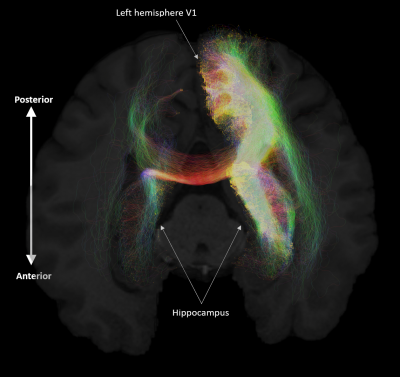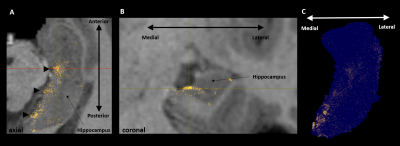Marshall Axel Dalton1, Arkiev D'Souza2, Jinglei Lv1, and Fernando Calamante3
1School of Biomedical Engineering, Faculty of Engineering, University of Sydney, Sydney, Australia, Sydney, Australia, 2DVC Research, Brain and Mind Centre, University of Sydney, Sydney, Australia, Sydney, Australia, 3Sydney Imaging, University of Sydney, Sydney, Australia, Sydney, Australia
1School of Biomedical Engineering, Faculty of Engineering, University of Sydney, Sydney, Australia, Sydney, Australia, 2DVC Research, Brain and Mind Centre, University of Sydney, Sydney, Australia, Sydney, Australia, 3Sydney Imaging, University of Sydney, Sydney, Australia, Sydney, Australia
We
observed striking differences in structural connectivity between
anterior/middle/posterior portions of the hippocampus and cortical regions and that
specific cortical regions may preferentially target circumscribed regions
within the hippocampus.

A representative example of streamlines connecting a specific cortical ROI and the bilateral hippocampus. (A) We present streamlines between the left hemisphere area V1 and bilateral hippocampus overlaid on a T1 structural scan viewed in the axial
plane for anatomical reference. Note the dense innervation of the ipsilateral
hippocampus and the comparatively weak innervation of the contralateral
hippocampus.

Representative
images showing (A) endpoints associated with streamlines between the left retrosplenial
cortex and left hippocampus overlaid on a T1 structural image viewed in the
axial plane. Note clusters of endpoints (marked by black triangles) along the
anterior-posterior axis of the hippocampus. (B) the coronal plane corresponding
with the red line in A. Note clusters are clearly localised in the medial
hippocampus. (C) A 3D rendering of endpoints overlaid on a transparent
hippocampus mask viewed in the axial plane.
